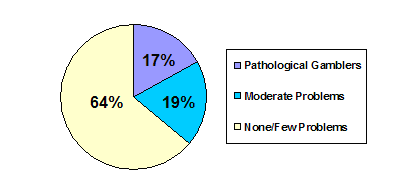Although anyone who gambles can become a disordered gambler, there is evidence suggesting that certain groups might be at greater risk (e.g., McNeilly & Burke, 2000; Shaffer & Hall, 1996). For example, certain groups might be at increased risk for disordered gambling due to age, depressed economic or social status, low education level, lack of accessibility to information, and a variety of other factors. This week’s WAGER presents the results of a study by Bazargan, Bazargan and Akanda (2000) that examined the effects of gambling on one demographic group often presumed to be at high risk—elderly African Americans.
Bazargan et al. (2000) studied 80 (16 male) African Americans aged 60 or older to determine their gambling-related problems and psychological state. The authors selected participants from Los Angeles-based senior centers that operate trips to gambling venues in Nevada for little or no cost. Trained personnel, middle-aged African American females, conducted face-to-face interviews with each subject. The authors noted that gambling problems “were measured by 19 items adopted from the South Oaks Gambling Screen” (p. 56) to assess behavioral changes attributable to gambling. The 53-item Brief Symptom Inventory (BSI, Derogatis, 1993) measured subjects’ self-reported psychological symptom patterns. The authors used a 16-item scale (Holmes & Rahe, 1967) to measure participants’ level of stress due to negative life events.
In the study sample, the total number of gambling-related problems ranged from 0 to 17 with a mean of 2.6 (SD = 3.3). The authors used the number of reported problems to create three groups: (1) scores of 7 and higher (pathological gamblers), (2) scores of 4 to 6 (moderate problems), and (3) scores of 0 to 3 (none/few problems). According to this procedure, 17% of the sample were pathological gamblers, 19% had a moderate number of problems, and 64% none to few problems (see Figure 1). Bazargan et al. found a statistically significant* relationship between increased gambling-related problems and several psychological conditions. Specifically, pathological gamblers were more likely than other types of gamblers to exhibit lower levels of subjective well-being, higher levels of anxiety and increased obsessive-compulsive tendencies. Pathological gamblers also tended to report greater numbers of stressful life events than those with no/few problems.
Figure 1. Percentage of gamblers by type in a sample of elderly African Americans (n=80) (Bazargan et al., 2000)
Because the composition of the sample heavily favored females (80%), the results might not be representative of the elderly African American population as a whole. A sample with such a large majority of females is likely to skew results in the direction of female-specific characteristics, and underestimate the males’ attributes. Further, the authors did not compare the gambling and psychological problems of elderly African Americans with those of elderly subjects from different backgrounds; therefore, there is no basis for comparison between African Americans to the elderly population as a whole. Also, the authors focused only on subjects who frequented senior centers that operated gambling trips. This strategy fails to represent seniors who only visit centers that do not sponsor trips or do not visit senior centers at all. Future studies would improve on this study by including descriptive group statistics for the psychological variables. Doing so would make it possible for the reader to determine the clinical significance (e.g., whether mean anxiety levels fell within the normal range) of the findings.
Despite these concerns, Bazargan et al. bring attention to the need for science to assess the impact of gambling on various segments of potentially vulnerable populations that are exposed to gambling, not just the population as a whole. Increased attention to demographic subdivisions will more completely describe the prevalence of psychological problems that are concomitant with gambling problems within specific groups, which could yield improved methods of treating specific vulnerable populations.
Comments on this article can be addressed to Tony Donato.
Notes
* The authors did not include information on group statistics (e.g., means) for the wellness variables. All F tests were significant at p<.05 or less.
References
Bazargan, M., Bazargan, S. H., & Akanda, M. (2000). Gambling habits among aged African Americans. Clinical Gerontologist, 22(3/4), 51-62.
Derogatis, L. R. (1993). Brief System Inventory: Administration, scoring and procedures manual-1. Baltimore: Johns Hopkins University of Medicine.
Holmes, T. H., & Rahe, R. H. (1967). The Social Readjustment Rating Scale. Journal of Psychosomatic Research, 11, 213-218.
McNeilly, D. P., & Burke, W. J. (2000). Late life gambling: The attitudes and behaviors of older adults. Journal of Gambling Studies, 16(4), 393-415.
Shaffer, H. J., & Hall, M. N. (1996). Estimating the prevalence of adolescent gambling disorders: a quantitative synthesis and guide toward standard gambling nomenclature. Journal of Gambling Studies, 12(2), 193-214.





